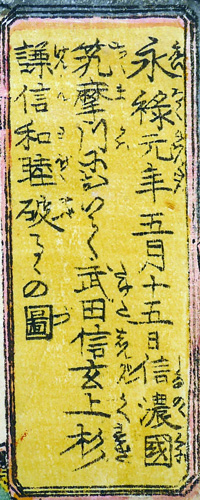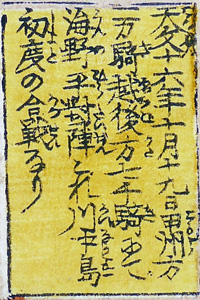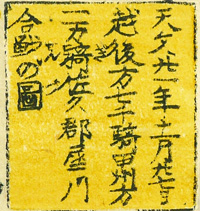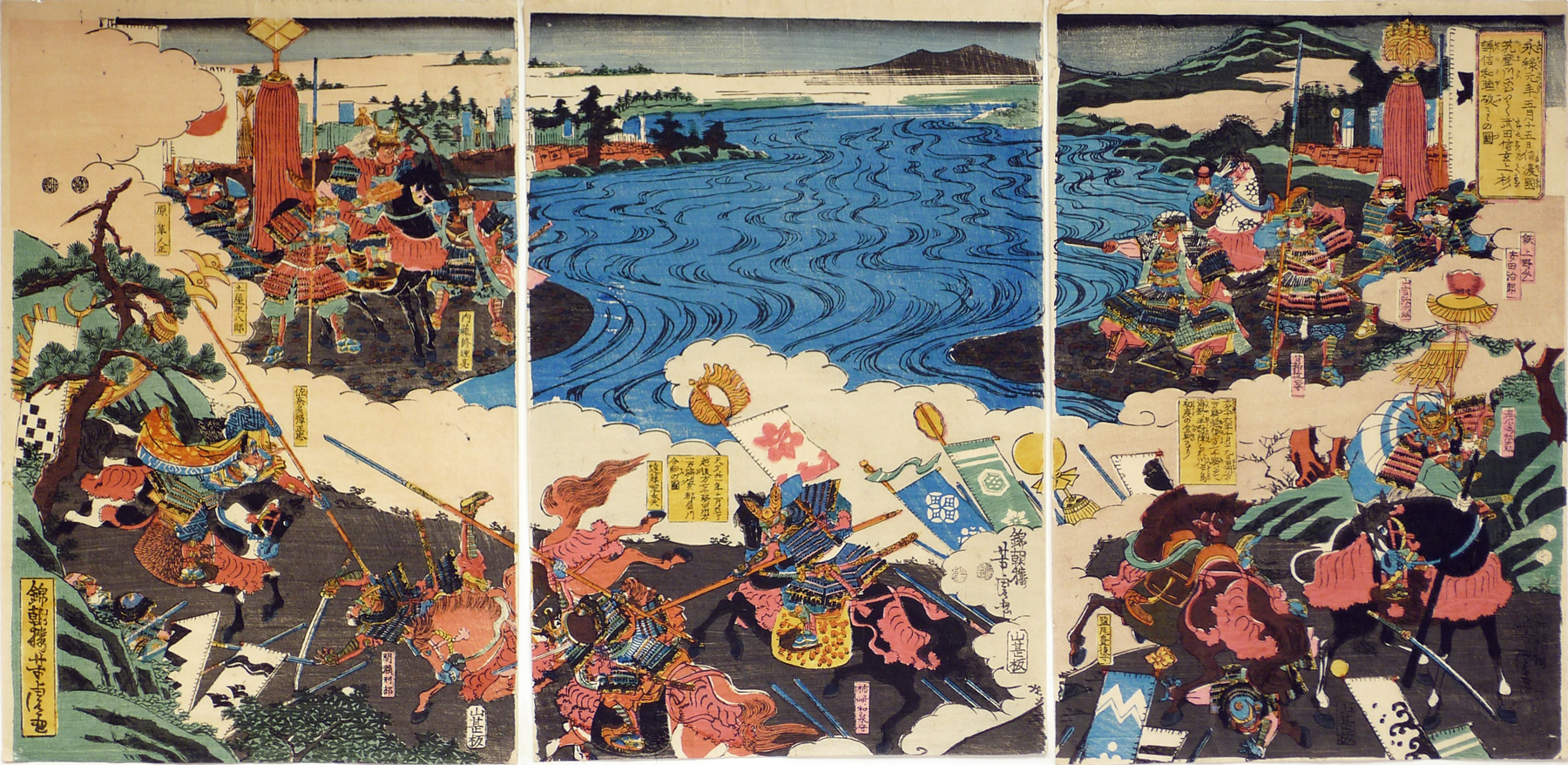About This Print
Rival daimyo Shingen Takeda (武田 信玄, 1521-1573) of Kōshū 甲州 (also known as Kai) province and Kenshin Uesugi (上杉 謙信, 1530-1578) of Echigo 越後 province face off on either side of the Sai River running through the fertile plains of Kawanakajima in northern Shinano Province (modern Nagano Prefecture.) Three battles in the long-running warfare between Shingen and Kenshin are depicted with each battle scene defined by irregular stylized clouds traditionally used in Japanese paintings to separate narrative scenes. Kenshin, on the right bank, sits on a folding stool holding a sword while Shingen, on the left bank, sits on his horse with an iron war fan (tessen). Various military commanders for both daimyo are pictured and named in the small cartouches throughout the print.
From 1553 to 1564 five battles occurred between the two daimyo in the Kawanakajima area that have come to be known as the Battles of Kawanakajima 川中島の戦い. While this print depicts one engagement during that period, it also depicts two earlier battles. (See "Translations of Explanatory Cartouches" below.)
Translations of Explanatory Cartouches
Source: webpage of Takahashi Sangyo http://artinlife.nw.shopserve.jp/framart/ukiyoe_art/yoshitora-06-05.html for Japanese transcription
While this print does not carry a specific title, it does contain descriptive information on the scenes in the three large yellow cartouches, as follows:
 筑摩川に於いて武田信玄上杉 謙信和睦破るヽの図 On the 15th day of the 5th month, 1558 Takeda Shingen and Uesugi Kenshin violated the peace on the Chikuma River in Shinano province. |  天文十六年十月十九日甲州方 天文十六年十月十九日甲州方一万騎越後方七千騎にて 海野平対陣これ川中島 初度の合戦なり On the 19th day of the 10th month, 1547 ten thousand horsemen from Kōshū and seven thousand horsemen from Echigo fought at Unnodaira in Shinano for the first battle at Kawanakajima. |
 天文二十一年十一月二十七日 越後方七千騎甲州方 一万騎佐久郡犀川 合戦の図 On the 27th day of the 11th month, 1552 seven thousand horsemen from Echigo and ten thousand horsemen from Kōshū battled at the Sai River in the Saku district. |
While researching this print I came across a suggestion (on the previous sited webpage of Takahashi Sangyo), unconfirmed by other sources, that this collection's print is part of a six panel print as shown below. While the three panels on the left continue the theme of the panels on the right and were also published by Yamashiroya Jinbei, the adjoining panels do not form a convincing match leaving me to believe they were not issued as a single six panel composition.
One of Five Prints from The Lavenberg Collection
loaned to the Portland Art Museum for the exhibition
"Legendary Samurai" September 14, 2013 to January 12, 2014
歌川芳虎画 武田信玄と上杉謙信三つの戦い
Utagawa Yoshitora(Japanese, active 1830s–1870s)
Three Battles between Takeda
Shingen and Uesugi Kenshin
1847/1853
Color woodblock print
Lent by The Lavenberg Collection of Japanese Prints
Takeda Shingen (1521–1573) and Uesugi Kenshin (1530–1578) are regarded as the most brilliant military strategists in Japanese history.Had circumstances been otherwise, either of these warlords might have unifiedthe country under their rule. Instead, their bitter rivalry trapped them inendless conflict with each other.
In this ambitious triptych, Utagawa Yoshitora presentsa synopsis of three battles fought by these warrior paragons of the banks ofthe Chikuma River. Kenshin, his head covered with the white cloth of a novicemonk, sits on a camp stool at right, directing his troops with his war fan.Shingen, astride a black charger, glares back from the left bank. Their subordinatesare identified by small cartouches throughout the print.PowerPoint Presentation Notes from 1-31-2017 Presentation
Three Battles [1547,1552, 1558], BetweenTakeda Shingen and Uesugi Kenshin, c. 1850
This print is an amalgamation of three 16th century battles fought between the warlords Takeda TakedaShingen (1521–1573) and Uesugi Kenshin (1530–1578) whose bitter rivalry kept them locked in endless conflict. They are regarded as the mostbrilliant military strategists in Japanese history.
Prints of warriors (musha-e)and war (senso-e) go back to the mid-1600s. They were marked by fluiditybetween fact and fiction, truth and fable. Thisc. 1950 print ThreeBattles [1547, 1552, 1558], Between Takeda Shingenand UesugiKenshinistypical of many Edo period wartriptychs, chock full of warriors and cartouches describing the battlesdepicted.
Three Battles [1547,1552, 1558], BetweenTakeda Shingen and Uesugi Kenshin, c. 1850 This print is an amalgamation of three 16th century battles fought between the warlords Takeda TakedaShingen (1521–1573) and Uesugi Kenshin (1530–1578) whose bitter rivalry kept them locked in endless conflict. They are regarded as the mostbrilliant military strategists in Japanese history. Prints of warriors (musha-e)and war (senso-e) go back to the mid-1600s. They were marked by fluiditybetween fact and fiction, truth and fable. Thisc. 1950 print ThreeBattles [1547, 1552, 1558], Between Takeda Shingenand UesugiKenshinistypical of many Edo period wartriptychs, chock full of warriors and cartouches describing the battlesdepicted. |
Print Details
| IHL Catalog | #463 |
| Title or Description | (untitled) Depiction of three battles between the armies of the daimyo Shingen Takeda and Kenshin Uesugi |
| Artist | Utagawa Yoshitora (fl. c. 1836-1882) |
| Signature |  |
| Seal | no artist's seal |
| Publication Date |  |
| Publisher |  |
| Impression | excellent |
| Colors | excellent |
| Condition | excellent - minor loss repaired from back upper left margin right panel |
| Genre | ukiyo-e; musha-e |
| Miscellaneous | on loan to the Portland Art Museum for "Legendary Samurai". Portland Art Museum loan number L2013.80.2 The MFA, Boston carries the following entry for this print:
|
| Format | vertical oban triptych |
| H x W Paper | 14 3/4 x 9 7/8 in. (37.5 8 x 25.1 cm) each sheet |
| Literature | |
| Collections This Print | Museum of Fine Arts, Boston 11.41340a-c |



